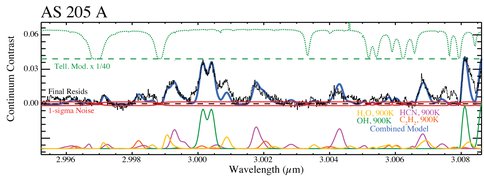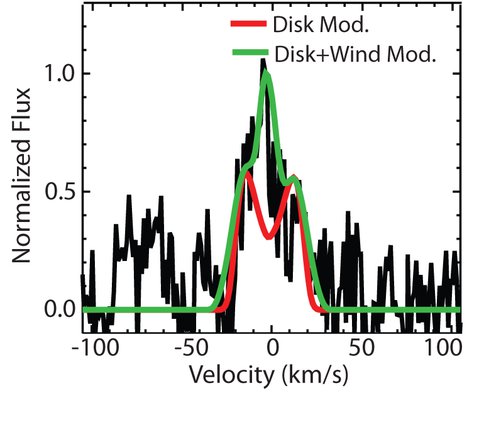2011 Annual Science Report
 NASA Goddard Space Flight Center
Reporting | SEP 2010 – AUG 2011
NASA Goddard Space Flight Center
Reporting | SEP 2010 – AUG 2011
NIR Spectroscopic Observations of Circumstellar Disks Around Young Stars
Project Summary
As a research scientist in the Planetary Systems Laboratory at NASA GSFC, A. Mandell studies the formation and evolution of planetary systems and the structure and composition of the atmospheres of extra-solar planets utilizing near-infrared spectroscopy. Mandell’s current observing campaigns focus primarily on high-resolution ground-based spectroscopy of circumstellar disks and extrasolar planetary transits and secondary eclipses using instruments on the Keck II telescope and the Very Large Telescope. Additionally, Mandell assists as a co-investigator on computational studies of terrestrial planet formation and evolution using N-body simulations of planetary accretion.
Project Progress
Using the NIRSPEC instrument on the Keck telescope and the CRIRES instrument on the VLT, we have made the first NIR detection of emission from organic molecules in the inner regions of circumstellar disks. We have successfully detected HCN and C2H2 in the L band for the first time in the T Tauri stars AS 205 A, DR Tau, and RU Lup (Mandell et al. 2011, submitted; Figure 1), and combined with additional sensitive upper limits for CH4 in DR Tau, we can constrain the emitting region to close to 1 AU (Figure 2). Measuring multiple molecular tracers in a single source (HCN, H2O, OH, and C2H2) at once allows us to accurately compare quantities such as the relative Doppler velocity shifts and molecular abundances, and preliminary analysis suggests there may be two separate velocity components – a disk component in Keplerian rotation around the star, and a slow disk wind that is being released from the surface of the disk (Figure 3).
Figure 1. Previous CRIRES data for the bright T Tauri star AS 205 A, demonstrating the detection of molecular features using our data reduction algorithms. The photon-limited S/N is ~600, and distortions from telluric contamination are completely removed. Emission lines from H2O, OH, and HCN, and C2H2 are clearly detected across multiple detectors.
Figure 2. Plot of model chemical abundances from Agundez et al. 2008 (lines), with our measured abundance ratios overplotted in shaded regions. Our results match well with expected values for the inner disk except for OH, which is most likely radiatively pumped (non-LTE).
Figure 3. Trace for a single HCN transition from AS 205 A (black), with different disk models overplotted. A slow disk wind w/ a Keplerian disk is required to fit the data.
These new molecular gas tracers will allow us to constrain the disk conditions in the region where planets are forming, providing information on disk structure (e.g. inner gas evacuation, vertical temperature gradient, and dust coagulation timescales) and composition (e.g. condensation fronts, C/O ratio) and aiding in further improvements to computational planet formation and disk evolution models. We are now extending this work to characterize a full suite of molecular species in a larger sample of disks of different masses and ages, in order to better understand the chemical balance and thermal conditions in different environments and evolutionary states. We have a large observing program in 2011/2012 with the VLT/CRIRES, and we are combing through previous observations with NIRSPEC using our new data reduction tools to identify emission from these extremely weak emission features. This work will also lay the groundwork for observations of circumstellar disks with the next generation of near-IR and mid-IR instruments.
NIR Characterization of Exo-planet Atmospheres
We are now initiating a program to apply the high-resolution, high-contrast spectroscopic techniques developed for circumstellar disk observations to the characterization of NIR thermal emission and stellar-light absorption due to the atmospheres of known transiting extra-solar “hot Jupiter” planets. Numerous previous ground-based searches for exo-planet signatures in the near infrared (primarily at 2.1 μm) have been unsuccessful, but planet-star flux ratios in the L-band (3 – 4 μm) are 10 times larger and absorption lines are prominent over a large range in wavelength, and at high resolution we can use the Doppler shift of the planet over time to remove stellar features and pull out the planetary spectrum. This technique can be used for both transiting and non-transiting planets, making it especially useful for probing a wide range of planetary orbit parameter space. The high resolving power (R ~ 25,000) of these observations would allow us to isolate specific spectral lines formed over a range of height in the atmosphere and quantify temperature versus vertical height for a range of molecules. We can measure a wide range of molecules such as H2O, CH4, and other hydrocarbons, and characterize the presence and formation height of any strongly-absorbing atmospheric absorbers, which are theorized to lead to variations in temperature structure seen by Spitzer photometry. We can also break the mass-inclination degeneracy for non-transiting planets by determining the inclination of the orbit from thevelocity shift of the planetary features, an important factor usually thought to require difficult astrometric observations.
The first exoplanet we have targeted is HD 189733b, due to its close proximity to the Sun (19 parsecs) and the favorable planet-star contrast expected based on Spitzer observations. Even before we have conclusively detected the planet, we can rule out a detection of the strong emission feature at 3.25 μm that was recently reported in the journal Nature. Using low resolution spectroscopy, Swain et al. (2010) reported a detection of a very bright emission feature extending from 3.1 to 3.5 μm; the authors attributed it to non-LTE emission from methane in the planet’s atmosphere. Our data probes a portion of the wavelength spectrum near the peak of the reported emission, and with high-resolution spectra the expected emission lines should be 40 times stronger than our uncertainly limits. We see no sign of any emission (Figure 4), with the most likely explanation being that Swain et al. did not properly account for changes in the water vapor in our own atmosphere (Mandell et al. 2011). We are now developing analysis techniques to determine the presence of very low-amplitude features through correlation with different atmospheric models; even upper limits constraining different atmospheric chemistry will be an important contribution.
Figure 4. Purported CH4 detection by Swain et al. 2010 (left), and results from our data reduction (right), with molecular models for candidate species plotted above our final residuals. Models for CH4 (top) and H2O (bottom) with different excitation temperatures are plotted above. We detect no emission at any of the expected positions, with upper limits > 30 times below the expected line strengths. From Mandell et al. (2011).
We are also analyzing data for the super-Earth GJ1214b, recently detected around a nearby M-dwarf (Charbonneau et al., 2009), which orbits at a distance where the incident flux results in an equilibrium temperature of ∼ 500K. Our observing team was granted time on Keck to observe six transits of GJ1214b this year through a combination of the Caltech and NOAO observing programs; of these six transit opportunities, we obtained useable data for five of them. This data set will comprise the best opportunity to detect atmospheric signatures of the exoplanet, and the multiple epochs of the observations (spread out over 8 months) will aid in providing confirmation of the detection by tracking the motion of the spectral features as the heliocentric radial velocity changes.
Publications
-
Raymond, S. N., Armitage, P. J., Moro-Martín, A., Booth, M., Wyatt, M. C., Armstrong, J. C., … West, A. A. (2011). Debris disks as signposts of terrestrial planet formation. A&A, 530, A62. doi:10.1051/0004-6361/201116456
-
Walsh, K. J., Morbidelli, A., Raymond, S. N., O’Brien, D. P., & Mandell, A. M. (2011). A low mass for Mars from Jupiter’s early gas-driven migration. Nature, 475(7355), 206–209. doi:10.1038/nature10201
-
PROJECT INVESTIGATORS:
-
RELATED OBJECTIVES:
Objective 1.1
Formation and evolution of habitable planets.
Objective 1.2
Indirect and direct astronomical observations of extrasolar habitable planets.
Objective 3.1
Sources of prebiotic materials and catalysts




